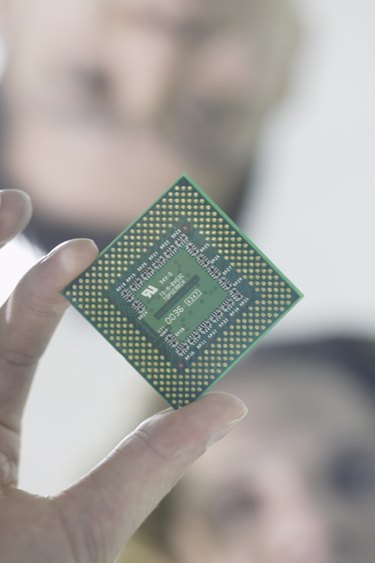
The CPU (central processing unit) is the processor of your computer: the component that physically performs the calculations that make up "computing." RAM (random access memory) is a form of memory, which is the temporary storage of information ready to be processed (as opposed to simply being stored for future reference.) RAM isn't the only form of memory; your computer can also use your hard drive and even removable media such as USB sticks for memory. Increasing RAM may speed up your computer but it won't necessarily solve the problem of high CPU use.
Percentages
Video of the Day
Tools such as the Windows Task Manager may display percentage figures for both CPU and RAM, but these refer to different things. The CPU figure shows the actual level of activity the processor is carrying out as a percentage of the total possible activity. The RAM figure shows how much of the RAM is currently being used to hold data for quick access by the CPU.
Video of the Day
Issues
If your CPU runs at 100% (full capacity) for an extended period, you may notice slowed performance. It increases the physical strain on the disk, so you may notice a lot of noise, some of which may be your computer's cooling fan running at full blast. Having 100% memory use isn't inherently a major problem: it's a bit like having a reference library or in-tray by your desk that is close to or completely full. However, CPU use at 100% is usually a sign something is wrong.
Benefits of RAM Upgrade
A RAM upgrade increases your computer speed in many circumstances. This is simply because your processor retrieves more of the data it needs from RAM rather than other, more slow to access memory locations such as your hard drive. It's a bit like making more space on your physical desktop to store documents for quick reference so that you don't need to spend extra time walking back and forth to a filing cabinet. Of course, if your existing RAM use is rarely at or close to 100%, you likely won't notice much benefit by increasing it.
Limitations
If your CPU is frequently running at or near 100%, having more RAM won't solve the problem. If your processor is running at full blast, it doesn't matter if it is able to access data any more quickly as it won't be able to process that data any faster. You may be able to solve this problem by installing a faster CPU that is less likely to frequently hit its maximum performance. However, in many cases a 100% CPU figure may indicate a problem with a particular application that is unnecessarily consuming large amounts of CPU power.
32-bit Limit
Modern computers are either 32-bit or 64-bit models and run versions of software to match. Bit refers to how much information the computer can physically process at a single moment. The way 32-bit computers and operating systems work means that they can only make use of 4GB of RAM in theory, and a little less than this in practice. If you install more than 4GB of RAM on a 32-bit machine it will continue to work but you will not get any added benefit or extra performance.